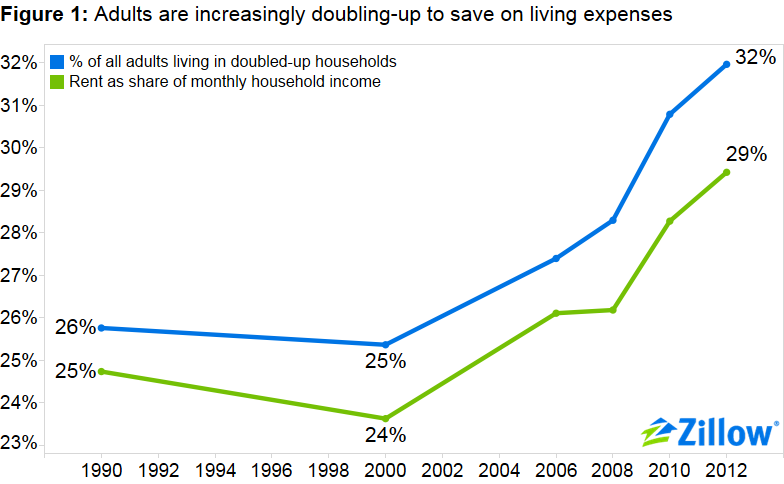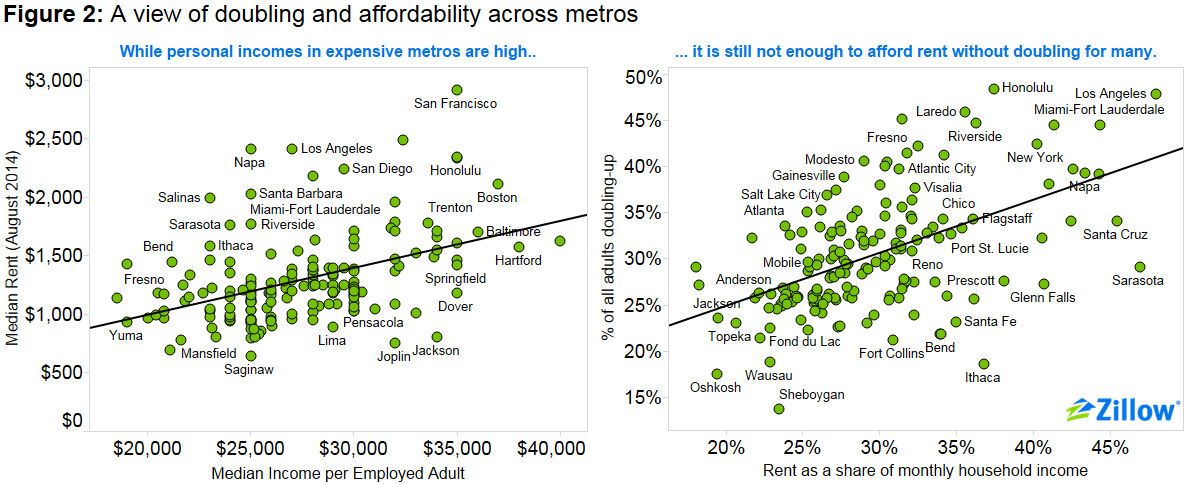- Nationally, 32 percent of working-age adults – aged 23 to 65 – live in doubled-up households, up from 25 percent in 2000 and 26 percent in 1990.
- Employed U.S. adults in doubled-up households make 76.3 percent as much as employed adults in general, or roughly 76 cents for every dollar made by all adults.
- The proportion of adults doubling-up is higher in more expensive markets.
As rents rise and income growth remains flat in many areas, renters are increasingly forced to devote an ever-larger share of their monthly income towards rent. In the second quarter, a typical American renting household spent 29 percent of their income on rent, compared to 25 percent in 1990 and 24 percent in 2000.
There are a number of strategies to cope with rising rents and stagnating incomes, including moving to a smaller home and/or moving to a cheaper area. But the likely first choice for many is to add more roommates to the household in order to spread the costs around, which creates more doubled-up households nationwide. Nationally, 32 percent of working-age adults – aged 23 to 65 – live in doubled-up households, up from 25 percent in 2000 and 26 percent in 1990.
We define a doubled-up household as one in which at least two working-age, unmarried or un-partnered adults live together. Under this definition, a 25-year-old son living with his middle-aged parents is a doubled-up household, as is a pair of unmarried 23-year-old roommates. This definition captures the households that under different circumstances contain adults who could or would choose to live apart. 
Some individuals do choose to live with others for companionship and camaraderie. But the relatively lower individual incomes of employed adults living in doubled-up households, and the strong relationship between rental affordability and the share of adults in doubled up households over time and across metro areas suggests that sharing living expenses is more than a matter of taste.
Nationally, employed adults in doubled-up households make 76.3 percent as much as employed adults in general, or roughly 76 cents for every dollar made by all adults. By doubling-up, a combined income is better able to compete for housing with individuals and families in a position to forgo doubling.
Corroborating the relationship between the tendency to seek roommates and housing affordability, as the share of household income needed for rent increases over time, so too does the share of adults doubling (Figure 1). Likewise, while employed individuals in expensive markets make more money than employed individuals in less expensive markets (top plot, Figure 2), the proportion of doubling is also higher in expensive markets (bottom plot, Figure 2). This suggests that higher incomes are not enough; individuals still need to pool their earnings and double-up to afford rent in expensive markets like San Francisco, Los Angeles and New York.
The share of working-aged adults living in doubled-up households is a custom analysis of individual census survey responses available in the Integrated Public Use Microdata Series.[1]
[1] Steven Ruggles, J. Trent Alexander, Katie Genadek, Ronald Goeken, Matthew B. Schroeder, and Matthew Sobek. Integrated Public Use Microdata Series: Version 5.0 [Machine-readable database]. Minneapolis: University of Minnesota, 2010.
